

Physiognomy. Illustration in a 19th-century book about physiognomy.
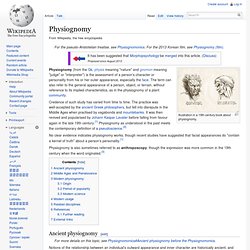
Credence of such study has varied from time to time. The practice was well-accepted by the ancient Greek philosophers, but fell into disrepute in the Middle Ages when practised by vagabonds and mountebanks. It was then revived and popularised by Johann Kaspar Lavater before falling from favour again in the late 19th century.[1] Physiognomy as understood in the past meets the contemporary definition of a pseudoscience.[2] No clear evidence indicates physiognomy works, though recent studies have suggested that facial appearances do "contain a kernel of truth" about a person's personality.[1]
Grok. Grok /ˈɡrɒk/ is a word coined by Robert A.
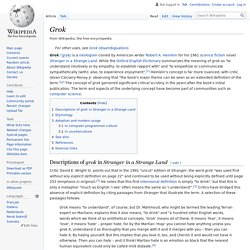
Heinlein for his 1961 science-fiction novel, Stranger in a Strange Land, where it is defined as follows: Grok means to understand so thoroughly that the observer becomes a part of the observed—to merge, blend, intermarry, lose identity in group experience. It means almost everything that we mean by religion, philosophy, and science—and it means as little to us (because of our Earthling assumptions) as color means to a blind man. The Oxford English Dictionary defines to grok as "to understand intuitively or by empathy; to establish rapport with" and "to empathize or communicate sympathetically (with); also, to experience enjoyment". Etymology[edit] Robert A. According to the book, drinking water is a central focus on Mars, where it is scarce. Heinlein describes Martian words as "guttural" and "jarring". Adoption and modern usage[edit]
Cognate. Minisaga. A minisaga, mini saga or mini-saga is a short piece of writing containing exactly 50 words, plus a title of up to 15 words.

However, the title requirement is not always enforced and sometimes eliminated altogether. Minisagas are alternately known as microstories, ultra-shorts stories, or fifty-word stories. The idea was originally invented by writer Brian Aldiss and the newspaper The Daily Telegraph, which has held several minisaga competitions. Drabble. A drabble is an extremely short work of fiction of exactly one hundred words in length,[1][2][3] not necessarily including the title.[4] The purpose of the drabble is brevity, testing the author's ability to express interesting and meaningful ideas in an extremely confined space.

The concept is said to have originated in UK science fiction fandom in the 1980s; the 100-word format was established by the Birmingham University SF Society, taking a term from Monty Python's 1971 Big Red Book.[1][4] In the book, "Drabble" was described as a word game where the first participant to write a novel was the winner. In order to make the game possible in the real world, it was agreed that 100 words would suffice. 55 Fiction[edit] Criteria[edit] A literary work will be considered 55 Fiction if it has: Fifty-five words or less. See also[edit] Flash fiction External links[edit] References[edit] Intertextuality. Intertextuality is the shaping of a text's meaning by another text.
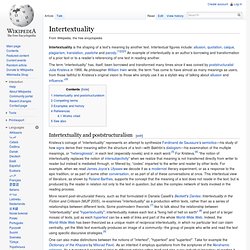
Intertextual figures include: allusion, quotation, calque, plagiarism, translation, pastiche and parody.[1][2][3] An example of intertextuality is an author’s borrowing and transformation of a prior text or to a reader’s referencing of one text in reading another. Intertextuality and poststructuralism[edit] More recent post-structuralist theory, such as that formulated in Daniela Caselli's Beckett's Dantes: Intertextuality in the Fiction and Criticism (MUP 2005), re-examines "intertextuality" as a production within texts, rather than as a series of relationships between different texts. Universal Character Set. Characters (letters, numbers, symbols, ideograms, logograms, etc.) from the many languages, scripts, and traditions of the world are represented in the UCS with unique code points.
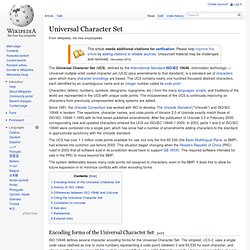
The inclusiveness of the UCS is continually improving as characters from previously unrepresented writing systems are added. Since 1991, the Unicode Consortium has worked with ISO to develop The Unicode Standard ("Unicode") and ISO/IEC 10646 in tandem. The repertoire, character names, and code points of Version 2.0 of Unicode exactly match those of ISO/IEC 10646-1:1993 with its first seven published amendments.
After the publication of Unicode 3.0 in February 2000, corresponding new and updated characters entered the UCS via ISO/IEC 10646-1:2000. Unicode. Unicode logo.

Origin and development[edit] Unicode has the explicit aim of transcending the limitations of traditional character encodings, such as those defined by the ISO 8859 standard, which find wide usage in various countries of the world, but remain largely incompatible with each other. Many traditional character encodings share a common problem in that they allow bilingual computer processing (usually using Latin characters and the local script), but not multilingual computer processing (computer processing of arbitrary scripts mixed with each other).
Ro (artificial language) Ro did not begin with attempting to rival or supplant any other language whatever, either natural or artificial, nor was it suggested by any of them.
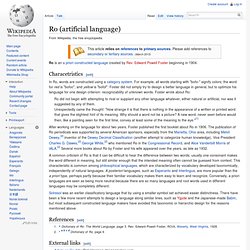
Unexpectedly came the thought: "How strange it is that there is nothing in the appearance of a written or printed word that gives the slightest hint of its meaning. Why should a word not be a picture? A new word, never seen before would then, like a painting seen for the first time, convey at least some of the meaning to the eye. "[1] A common criticism of Ro is that it can be difficult to hear the difference between two words; usually one consonant makes the word different in meaning, but still similar enough that the intended meaning often cannot be guessed from context. Solresol was an earlier classificatory language that by using a smaller symbol set achieved easier distinctness.